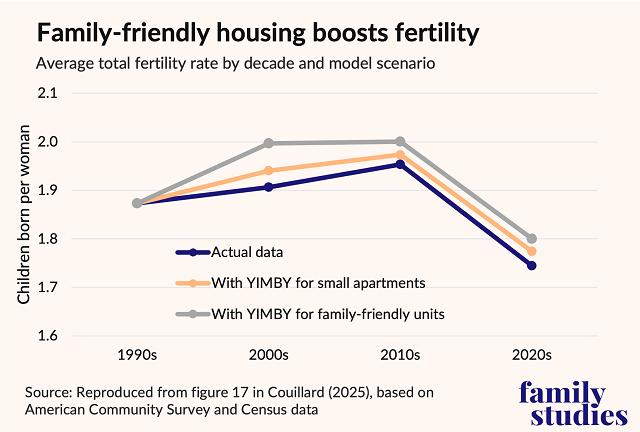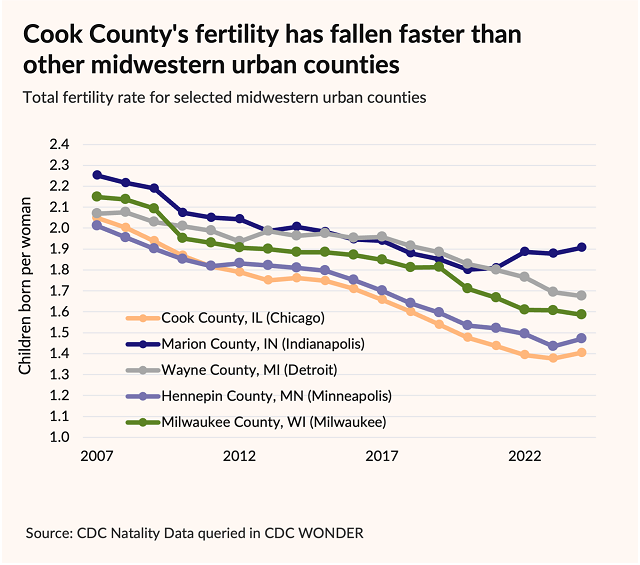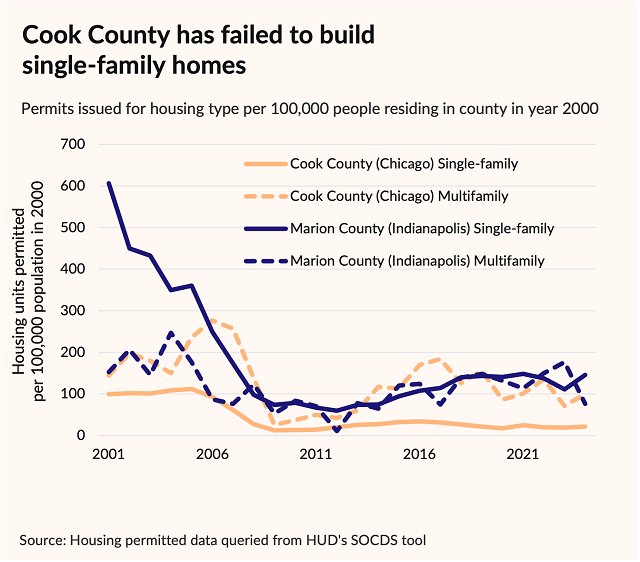Highlights
- A new study proves that building more family-friendly housing can jumpstart family formation far more effectively than just building tons of small apartments. Post This
- While building more houses in general can reduce housing prices enough to boost fertility somewhat, building fewer but bigger homes reduces costs less but increases fertility by twice as much, per a new study. Post This
- Had “YIMBY for small apartments” been implemented in the 1990s, fertility today would be 0.03 children more per woman. But had “YIMBY for family-friendly units” been implemented, fertility would be 0.06 children more per woman. Post This
- Marion County and Cook County are both building apartments at a similar pace. But Marion Co. is also building lots of single-family homes, while Cook Co. isn’t. Post This
Falling rates of marriage and fertility in America today are partly due to worsening housing conditions for young people, something we’ve shown extensively in recent research. Those deteriorating housing conditions are partly a basic supply problem: not enough housing is getting built. Moreover, the housing that is being built is increasingly unsuitable for family life, mostly because it has too few bedrooms compared to the overall size and price of the home. We’ve argued that both factors matter: America needs to build more houses, and it needs more family-friendly homes. But quantifying these two factors—pure supply increase vs. housing characteristics—is challenging.
Study: Family-Friendly Housing Is Key to Restoring Family Life
Luckily, a new study proves that our arguments in recent papers are correct: building more family-friendly housing can jumpstart family formation far more effectively than just building tons of small apartments. The authors use data on housing construction, housing type, rents, and household formation to show that while building more houses in general can reduce housing prices enough to boost fertility somewhat, building fewer but bigger homes reduces costs less but increases fertility by twice as much. The key figure is the last one in the paper, which we have reproduced below. The figure makes one simple point: if policymakers give the exact same subsidy (or deregulation) to small apartments vs. family-friendly units, the results differ significantly.

Had “YIMBY for small apartments” been implemented in the 1990s, fertility today would be 0.03 children more per woman—a small effect, but not nothing. But had “YIMBY for family-friendly units” been implemented, fertility would be 0.06 children more per woman. Again, this effect is small (and, it should be noted, the simulated subsidy is fairly small, too), but it is not as small. Policymakers can get more family formation from a given reform by ensuring that any such reform removes the specific obstacles to family-friendly housing.
What are those obstacles? Well, some things impact small and large houses alike: both types are impacted by very low floor area ratio limits, and both types are impacted by high parking requirements, for example. But some policy elements impact family-friendly housing more: small apartments are not impacted by minimum lot size rules, but family-friendly homes are, for example. Small apartments are not greatly affected by urban growth barriers and greenbelts, but family-friendly housing is. Parking requirements calculated per bedroom favor small units, while parking requirements per unit favor larger family-friendly units. Allowing more single-stair construction would enable more family-friendly units in an apartment building, while simply increasing height limits will tend to generate more small units. Allowing accessory dwelling units adds more small apartments, doing nothing for family-friendly units.
In cities that make efforts to build a broad spectrum of housing, like Indianapolis, fertility rates have fallen less and even show some signs of recovery.
Our argument at IFS has never been that policymakers should sabotage or prevent small units from being built—they help rein in market prices, and some people do need them for some stages of life. Rather, our argument is that many actual existing YIMBY proposals are biased in favor of small apartments. A proposal to upzone neighborhoods around transit will add a ton of small units, doing very little for families—but a proposal to reduce minimum lot sizes allows a lot of new family-friendly units while doing nothing for apartment developers. Because many YIMBYs are also committed “urbanists” who value extremely high walkability scores for neighborhoods, they often have a blind spot for how their policies impact the houses that actually help civilizations not collapse, i.e. those where people raise families.
Urbanist YIMBY Success Stories: Disasters for Family Life
This blind spot is also apparent in a recent YIMBY critique of our housing work. In Chicago, a large amount of new housing construction has come from small units in big buildings in the urban core. Yet, as shown in the piece linked above, the number of children in the urban core has risen! Does this disprove our argument that building lots of small apartments is not helpful to families?
Not really. If you build more apartments, somebody will live in them—and some of those apartment dwellers will be families. The relevant question is what happens to the rate of family formation. As it happens, based on the numbers reported to be critical of our view, the child share of downtown Chicago’s population fell from 16% in 2000 to 10% in 2010 and then to 9% in 2020: downtown Chicago grew in total numbers even as it became relatively less family friendly!
Moreover, this kind of neighborhood focus is a mistake. People often relocate when they have children or get married. The relevant question is: did building more housing in the Loop cause Cook County’s (the Chicago area’s) overall fertility to rise or fall vs. some reasonable comparison? A reasonable comparison might be “vs. other midwestern urban counties.” The figure below shows that, in fact, Cook County’s fertility fell more than any of the other major midwestern urban counties we checked.

The building boom in downtown Chicago evidently didn’t do anything to help families. It relocated some families into downtown apartments because that’s where the few available new houses were being built, but it didn’t really boost fertility.
Notice, however, that Indianapolis’ urban core in Marion County has seen rising fertility in recent years. The contrast between Marion County and Cook County could hardly be more distinct. The explanation for this deviation may be as simple as a difference in housing, as the figure below shows.

Marion County and Cook County are both building apartments at a similar pace. But Marion County is also building lots of single-family homes, while Cook County isn’t.
This speaks to the point we have been making repeatedly in our work. We are not opposed to building more small apartment buildings, as both Indianapolis and Chicago have done. But, in practice, the urbanist YIMBY success stories, like downtown Chicago, only involve the building of small apartments. Because they only build small apartments, family life sees little benefit.
But in cities that make efforts to build a broad spectrum of housing, like Indianapolis, fertility rates have fallen less and even show some signs of recovery.
Congress Should Pass Family-Friendly Housing Legislation
These blind spots are, unfortunately, present in currently proposed federal legislation. As we’ve written previously, the proposed “ROAD to Housing Act” overwhelmingly removes barriers to building studio apartments and 1-bedrooms, while mostly ignoring the challenges facing family-sized apartments and single-family homes. Luckily, these oversights can be easily fixed with some small tweaks we described in our previous post.
Lyman Stone is a Senior Fellow and Director of the Pronatalism Initiative at the Institute for Family Studies.














